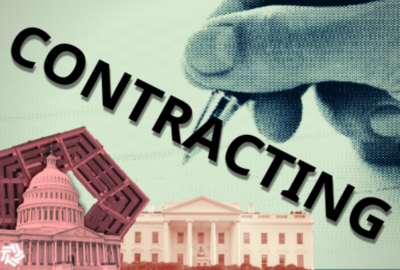Why contracting protest appeals are never a zero sum game
In federal contract protests, a company can't make a money appeal on a protest decision unless that appeal contains a specific dollar amount.
Among the more arcane rules of federal contract protests, a company can’t make a money appeal on a protest decision unless that appeal contains a specific dollar amount. It is called the “sum certain rule.” But is it really a hard and fast rule? And if not, what does that mean for the government and for contractors? For more, the Federal Drive with Tom Temin spoke with Haynes Boone procurement attorney Dan Ramish.
Interview Transcript:
And Dan, it sounds like a recent case overturned this idea of the sum certain rule. Tell us what happened.
Dan Ramish Sure, Tom. So, the FAR definition of a claim requires that any claim for money against the government or by the government against a contractor has to demand payment in a sum certain, which just means that it has to specify a specific amount that is claimed. And for many years, the sum certain requirement was treated as a jurisdictional rule. More specifically, it goes to the subject matter jurisdiction of a government contract, court or board. Meaning that a court or board couldn’t even hear a contract claim case unless the claim stated a sum certain a specific amount.
Tom Temin Where could you take a case if it didn’t have a certain sum?
Dan Ramish So if the claim submitted to the contracting officer didn’t stay to sum certain, it would get kicked back, dismissed for lack of subject matter jurisdiction and the contractor would have to start over if they could. But this was a very harsh rule because a jurisdictional rule can be raised at any time during the litigation. The government, if it’s a contractor claim, could lose the case and then raise the lack of jurisdiction over sum certain and the contractor would have to go back and submit a new claim to the contracting officer, even if they’ve been litigating for years. And if it had been more than six years. The statute of limitations under the Contract Disputes Act. The contractor would be out of luck. And actually, it’s sort of extreme circumstances like that that came up over the summer and caused the Federal Circuit to change its view of this rule. The case was ECC International Constructors v Secretary of the Army, and the Federal Circuit looked at a line of Supreme Court cases, which the Supreme Court has taken a stronger stance on what rules are considered jurisdictional because there are these harsh results, the rules can’t be waived or forfeited. The court actually has to raise them if the parties don’t do it. Requirement for the court raising the issue of suing. And it can be raised even after years of litigation and a hearing, and sometimes have very severe results.
Tom Temin So in other words, the government could lose the case on the merits of whether the protest was valid. But the contractor is still out of luck because the claim didn’t have a specific dollar attached to it.
Dan Ramish Exactly. And so, the Federal Circuit looked at these circumstances. ECC had been negotiating for years with the government and then went through years of litigation, and the government didn’t raise the issue of the sum certain rule until three months after the hearing. And this seemed like an extreme circumstance. The Federal Circuit actually raised the issue on its own accord, whether this was actually as a jurisdictional rule. And because this is such an extreme circumstance as such, special rules, the Supreme Court says Congress has to clearly state in the statute itself that this rule is jurisdictional. And in this case, this was open and shut. The FAR mentions sum certain requirement that claims have to stay to sum certain. But there’s nothing in the Contract Disputes Act, which governs contract claims against the government or by the government against the contractor.
Tom Temin Rights, the federal Acquisition Regulation, and took what was in the law, enabling it a step beyond what the law actually stated explicitly.
Dan Ramish That’s right. And the Federal Circuit said, listen, in most cases, this isn’t going to matter because it’s still a mandatory rule for submitting a claim. It’s just not jurisdictional. It doesn’t have this special status. So as a result, it can be forfeited. And here we’re dealing with a circumstance where the government waited so long. The board below should look at this again and consider whether the government forfeited its right. Waited too long to challenge the sum certain.
Tom Temin Got it. We’re speaking with Dan Ramish. He’s a procurement attorney with Haynes Boone, just give us the details of what they were protesting. They did not get a contract ECC. And said that they should have.
Dan Ramish So, Tom, this is a contract claim. The ECC decision was on a series of construction claims on a construction contract with the government. In the case of ECC, it was design build job for a military compound in Afghanistan. So, there were a number of questions. I mentioned that because this was a non-jurisdictional rule, it could be forfeited. But this Federal Circuit didn’t say how long you had to bring a challenge of the sum certain. And so now we have a few decisions interpreting the Federal Circuit’s decision and giving us some sense. So, one of those cases was actually the remand decision in the ECC case after the Federal Circuit said, well, this rule can be forfeited, they sent it back to the board to decide whether it actually was. And it was a pretty straightforward decision because, again, the government had waited until three months after the hearing. And the Federal Circuit, you know, in its decision, highlighted some of the other details. It was six years after the claim had been submitted. After settlement discussions, discovery, alternative dispute resolution with a board judge, summary judgment briefing and an appeal on a specific issue. So, the Federal Circuit pointed out and the board noted, hey, the government had many, many opportunities to challenge the sum certain and they didn’t do it until three months after the hearing.
Tom Temin Well, let me ask you this. In making the claim, why didn’t ECC put down an amount they were claiming in the first place?
Dan Ramish So this is one of the kind of wrinkles in the sum certain rule, Tom, in this case, and actually the two other recent decisions, it wasn’t a straightforward case of not stating a specific amount. The overall construction claim submission that ECC submitted to the government had an amount. But the government in its challenge said, well, actually you’re calling this one claim, but this is really multiple unrelated claims that there was a claim for delays associated with the government’s review of design submittals, 95 and 100% design submittals. And then there were a whole bunch of other government directed additional work and contract changes. And the government said those are different claims. They’re qualitatively different. They involve different operative facts. And so that’s why ECC submitted one claim. And this is this comes up a lot in construction contracts where there may be many different claim elements. The government said, hey, those are each claim under the FAR. They each require a sum certain as a mandatory requirement for the claim. And the board originally said, hey, this is correct. These are qualitatively different claims. They needed to sum certain it’s dismissed. Federal circuit said this isn’t a jurisdictional rule. So got kicked back to the board. And the board, applying the new test from the Federal Circuit above, found straightforwardly that the government had forfeited the right to challenge the sum certain by the time it raised it.
Tom Temin So does this mean that the FAR council has to get together and change the Federal Acquisition Regulation, the FAR, to reflect these new court rulings that sum certain is not quite so certain.
Dan Ramish So it doesn’t require a regulatory change, but the courts and boards are going to have to determine what the forfeiture rule is and whether contractors can correct the issue at during litigation or have to refile the claim with the contracting officer and then appeal it again.
Tom Temin But the main beneficiary here is contractors. It seems like it makes it a smoother pathway to sustaining a protest.
Dan Ramish Well, I can tell you, Tom, there are certainly instances where the government also brings large claims that are not broken out into subtotals that are distinct. DCAA will have an audit report that has a total amount, but it’s unclear how much is associated with the different parts of the claim. You can understand the reason that the contracting officer needs or the or the contractor in the case of government claim, needs to know how much the individual parts are in order to be able to settle them. And the government argues, reasonably that contractors sometimes kind of fudged the numbers a little bit, and they settle one part and then they say, actually, more was associated with this other part of the claim. So that can be an issue. But there’s a real question as to whether, after the contracting officer issues a final decision, is there any value in allowing the sum certain challenge later in the litigation? Because once you’re in at the board of contract appeals, you can actually change the amount of the claim, as long as you’re not changing the underlying basis for the claim, you can prove that you actually sustained more damages from the claim than what you put in your claim submitted to the contracting officer. So, it doesn’t make a whole lot of sense to then say that the underlying claim had a problem, and therefore you should go back and get a new final decision. So, some practitioners are saying, hey, there should be a mechanism for correcting this. Maybe the contractor or the government can alter its initial pleading. The contractor can amend the complaint. If the government says, hey, you didn’t give me a subtotal for this particular component. The contractor, you know, under board rules may be able to amend the complaint with the board’s permission. And maybe that’s a fix. Then everybody knows what the amount is. The claimant gives the other party the information they want, and everybody can move forward without having to go back to the drawing board with the new claim and final decision.
Tom Temin But it’s a good idea to track how much costs or loss is associated with each claim and keep that running tally to speed things up.
Dan Ramish Absolutely, Tom. I mean, there’s no question from the Federal Circuit’s decision that the sum certain rule remains a mandatory rule and that contractors in submitting a contractor claim in the government and submitting a final decision, that’s a claim against the contractor, need to state a sum certain. And if there are separate elements that are qualitatively separate. They need subtotals for those amounts. So, you need to provide a lot of information. But there may be greater leeway down the line if the other party raises an argument as kind of a gotcha. Certainly, if they wait until after the hearing, there’s a better chance of getting that argument kicked because they forfeited it. And now we have a couple of decisions that have actually done that and said the party waited too long and couldn’t bring us sum certain challenge.
Copyright © 2025 Federal News Network. All rights reserved. This website is not intended for users located within the European Economic Area.
Tom Temin is host of the Federal Drive and has been providing insight on federal technology and management issues for more than 30 years.
Follow @tteminWFED






